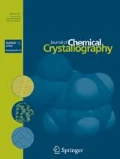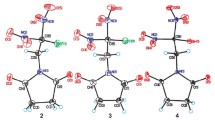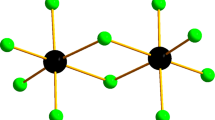Abstract
The crystal structures of three 3-halogeno derivatives of 13N-substituted cytisine have been determined by X-ray diffraction. The two 13-acetyl substituted compounds, 3-bromo (1) and 3-iodo (2) are isostructural, with the isostructurality index as high as 99%. They both crystallize in monoclinic P21 space group, with unit cell parameters of a = 8.4709(10) Å, b = 9.2266(12) Å, c = 8.6051(10) Å, β = 98.528(11)º (1) and a = 8.2322(6) Å, b = 9.1724(7) Å, c = 8.5494(6) Å, β = 98.181(7)º (2). In turn, 3-bromo-13-t-butyl-carbonate derivative (3) crystallizes in orthorhombic P212121 space group with a = 6.8171(3) Å, b = 7.8994(4) Å, c = 31.4657(15) Å. Conformation of the cytisine skeleton is similar in all three molecules, with almost planar A ring, sofa conformation of B-ring and C ring being an almost ideal chair. However, the orientations of the double C=O bonds in 13N-substituents are completely different: in 1 and 2 it is cis with respect to C12 (C12-N13-C14-O15 torsion angle is 3.3(4)º in 1 and 1.3(6)º in 2) while in 3 it is trans (−175.4(3)º). In the structures of 1 and 2 the driving force of the crystal architecture are quite strong C–H···X halogen bonds with C···X distances far shorter than the sums of van der Waals radii (C···Br in 1 is 2.9430(19) Å and C···I in 2 2.974(3)). In contrast in 3–partially as the consequence of different orientation of the substituent—there are no halogen bondings but instead some weak C–H···O contacts organize the molecules into two-dimensional patterns.
Graphical Abstract
In two 3-halogeno-N-acetyl cytosine derivatives the strong, directional halogen bonds influence the crystal packing, while for 3-bromo-N-t-butyl-carbonate derivative only weak hydrogen bonds are observed.

Similar content being viewed by others
Introduction
Cytisine is a natural quinolizidine alkaloid found in Fabacea plants such as Cytisus laburnum and Laburnum anagyroides [1].
For many years cytisine has been used for smoking cessation in central and eastern European countries [2, 3]. It is a partial agonist at the α4β2 nAChR. Cytisine also shows high affinity for other nAChR subtypes, but the therapeutic consequence of them is unknown. These receptors have been identified as promising targets for the treatment of several neurological disorders, such as Parkinson’s and Alzheimer’s diseases, Tourette’s syndrome, dyskinesias, schizophrenia, anxiety, attention deficit disorder, and pain [4–6]. Additionally, this natural compound was found to decrease nicotine-induced extra cellular dopamine release in the nucleus accumbens [7], and was shown to reduce ethanol drinking behaviors in mice or rats [8, 9] and ethanol-induced dopamine and its metabolite [10]. Therefore, nicotinic ligands could be developed as potential therapeutic candidates for binge-like ethanol drinking and dependence in humans.
Recent interest in the chemistry of cytisine (1) has been growing because of a lack of understanding as to the molecular basis of this underpinning partial agonist profile. In terms of analogues, manipulation of cytisine itself is readily achievable at C3 and C5, C10, and N12 [11–20] but interest in cytisine as a target for total synthesis has also been significant as well as the synthesis of cytisine derivatives [21, 22].
In this context, in the present work we have attempted to analyze the structures of cytisine derivatives halogenated at C3 position (Scheme 1): 3-bromo-N-acetylcytisine (1), 3-iodo-N-acetylcytisine (2) and 3-bromo-cytisine-N-t-butylcarbonylate (N-boc-3bromocytisine) (3) [15, 23, 24]. This side is favorable for binding to α4β2 nAChRs [22]. We believe that together with biological research our work can help to understand how their structural differences are responsible for their ability to bind to nicotinic receptors and their different affinities.
Results and Discussion
Figures 1, 2 and 3 show the perspective view of the molecules 1–3, respectively. Table 1 lists some essential geometrical parameters.
Two acetyl derivatives 1 and 2 are isostructural. They crystallize in the same space groups, the unit cells are very similar and the disposition of the molecules in the crystal structure is almost identical. The values of the indicators of isostructurality introduced by Kalman et al. [25] and modified by Szafrański and Kubicki [26] show that in this case the degree of isostructurality is very high. The isostructurality index which describes in principle the mean difference between the positions of analogous atoms in the unit cell is almost ideal, equals to 98.9%. Of course, also the geometrical parameters of these two molecules are quite similar, so similar that in principle they make a good example for the application of the normal probability distribution test [27, 28], which shows how far the differences between two molecules can be described as statistical only. In this case the correlation coefficient R2 for bond lengths (without the C–X bond) is 0.979 and for all bond angles −0.963. The linear regression equations confirm the frequently described overestimation of the standard uncertainties by a factor of 2.
Therefore in further analysis we will compare the 3-bromo-N-boc derivative (3) to 3-bromo-N-acyl derivative (1) only as 3-iodo-N-acyl compound (2) is almost identical with 1.
Overall conformations of the molecules are quite similar; the cytisine skeleton is stiff and the rings have almost the same shape. Interestingly, it turns out that the protonation of cytosine does not change its conformation (cf. [23, 24]); such a change was observed in e.g. sparteine (for instance, [29, 30]) or multiflorine derivatives (e.g. [31, 32]).The ring A (cf. Fig. 1) is almost planar, maximum deviation from the least squares planes are 0.020(3) Å in 1, 0.006(2) Å in 2 and 0.033(2) Å in 3. Rings B are all close to the sofa conformation; the asymmetry parameters [33] which describe the deviations of these rings from their ideal C s symmetry are 3.3, 5.8 and 3.7°. Finally, the rings C are almost ideal chairs, with the appropriate asymmetry parameters ΔC s and ΔC 2 not larger than 5°.
Some conformational differences between 3 on one side and 1 and 2 on the other should be however noticed (Fig. 4), and it turns out that these slight changes mean a lot for the crystal packing. First, the overall shape of the molecules can be defined by the dihedral angle between planar ring A and an approximately planar fragment from another site of the molecule, which is the mean plane of the C11, N12, C13, C14, O15, C(O)16 fragment. This angle differs quite significantly, it is 44.33(8)º in 3 and 55.50(9)º in 1 [56.57(14)º in 2]. Second, the orientation of the C14=O15 double bond is defined by e.g. the torsion angle C11–N12–C14–O15, and is completely different for 3 where it is −175.4(3)º (trans) and 1 where the orientation is cis—the value of the torsion angle is 3.3(4)º [1.3(6)º in 2].
The crystal structures of compounds 3 on one side and 1 and 2 on the other are determined by quite different weak intermolecular interactions. This might be regarded as another example of the competition between weak hydrogen bonds and so-called halogen bonds, and this competition in the present case influences the conformation of a side chain. In 3 there are some weak C–H···O interactions (Table 3), which organize molecules into a two-dimensional pattern (Fig. 5). These interactions are weak, as judged by their geometrical characteristics, but—looking at the crystal structure—they undoubtedly influence the crystal structure. In the structures of 1 and 2 the driving force of the crystal architecture are quite strong C–H···X halogen bonds (X=Br for 1, I for 2). This kind of interaction, postulated in the 1960s [34, 35] and confirmed as an important player in the determination of the crystal structure (e.g. [36, 37] and references therein), are in principle electrostatic interactions between a covalently bound halogen atom and the lone pair of the “acceptor” atom, and they should be quite directional. This is exactly the case in the crystal structures of 1 and 2, where the angles C–X···O are close to 180º while the angles C=O···X suggest the direction of the lone pair of the oxygen atom (cf. Fig. 6; Table 2). These interactions are quite strong in 1 and 2. In the Cambridge Structural Database (CSD, [38], version 5.33 of Nov. 2011) we have found 832 C–Br···O contacts with Br···O distances closer than the sum of appropriate van der Waals radii as defined by the CSD, but only less than 50 of them are closer or comparable to the Br···O distance in 1 (2.9430(19) Å). For iodine derivatives there are 337 fragments with I···O distances shorter than the sum of the van der Waals radii and only 40 closer than or equal to the distance in 2 (2.974(3) Å).
Experimental
The synthetic procedure has been described elsewhere [15, 23, 24]. Crystals appropriate for X-ray data collection were obtained from the MeOH-EtOH (1:1) solutions by slow evaporation at room temperature. Diffraction data were collected at room temperature by the ω-scan technique on an Oxford Diffraction Xcalibur four-circle diffractometer with Eos CCD-detector with graphite-monochromatized MoKα radiation (λ = 0.71073 Å). The data were corrected for Lorentz-polarization as well as for absorption effects [39]. Accurate unit-cell parameters were determined by a least-squares fit of 2312 (1), 5278 (2) and 4313 (3) reflections of highest intensity, chosen from the whole experiment. The structures were solved with SIR92 [40] and refined with the full-matrix least-squares procedure on F2 by SHELXL97 [41]. Scattering factors incorporated in SHELXL97 were used. The function Σw(∣Fo∣2−∣Fc∣2)2 was minimized, with w−1=[σ2(Fo)2 + (A·P)2+B·P] (P = [Max (F 2o , 0) + 2F 2c ]/3). The final values of A and B are listed in Table 1. Anisotropic atomic displacement parameters were refined for all non-hydrogen atoms. The hydrogen atoms were placed in geometrically idealized positions, and refined as rigid groups with their Uiso’s as 1.2 or 1.5 (methyl) times Ueq of the appropriate carrier atom. The absolute structure was assigned according to the known parent compounds, and it was additionally confirmed by the values of the Flack parameters [41] (Table 3). Programs XP [42] and Mercury [43] were used for graphic representations, used in figures. Relevant crystal data are listed in Table 1, together with refinement details.
Crystallographic data (excluding structure factors) for the structural analysis have been deposited with the Cambridge Crystallographic Data Centre, Nos. CCDC–851253 (1), CCDC–851254 (2) and CCDC–851255 (3). Copies of this information may be obtained free of charge from: The Director, CCDC, 12 Union Road, Cambridge, CB2 1EZ, UK. Fax: +44(1223)336-033, e-mail:deposit@ccdc.cam.ac.uk, or www: www.ccdc.cam.ac.uk.
References
Etter JF, Lukas R, Benowitz N, West R, Dresler C (2008) Drug Alcohol Depend 92:3
Tutka P, Zatoński W (2006) Pharmacol Rep 53:777
Polosa R, Benowitz NL (2011) Trends Pharmacol Sci 32:281
Cassels BK, Bermúdez I, Dajas F, Abin-Carriquiry JA, Wonnacott S (2005) Drug Discov Today 10:1657
Hogg RC, Bertrand D (2004) Curr Drug Target CNS Neurol Disord 3:123
Lloyd GK, Williams M (2000) J Pharmacol Exp Ther 292:461
Coe JW, Brooks PR, Vetelino MG, Wirtz MC, Arnold EP, Huang J, Sands SB, Davis TI, Lebel LA, Fox CB, Shrikhande A, Heym JH, Schaeffer E, Rollema H, Lu Y, Mansbach RS, Chambers LK, Rovetti CC, Schulz DW, Tingley FD 3rd, O’Neill BT (2005) J Med Chem 48:3474
Hendrickson LM, Zhao-Shea R, Tapper AR (2009) Psychopharmacology 204:563
Steensland P, Simms JA, Holgate J, Richards JK, Bartlett SE (2007) Proc Natl Acad Sci USA 104:12518
Sajja RK, Rahman S (2011) Progr Neuro-Psychopharmacol Biol Psychiatr 35:257
Frigerio F, Haseler CA, Gallagher T (2010) Synlett 729
Kozikowski AP, Chellappan SK, Ciao Y, Bajjuri KM, Yuan H, Keller KJ, Petukhov PA (2007) Chem Med Chem 2:1157
Chellappan SK, Ciao Y, Tueckmantel W, Keller KJ, Kozikowski AP (2006) J Med Chem 49:2673
Houllier N, Gouault S, Lasne M-C, Rouen J (2006) Tetrahedron 62:11679
Roger G, Lagnel B, Rouen J, Besret L, Valette H, Demphel S, Gopisetti J, Colon C, Ottaviani M, Wrenn LA, Letchworth SR, Bohme GA, Benavides J, Lasne M-C, Bottlaender M, Dollâe F (2003) Bioorg Med Chem 11:5333
Houllier N, Gopisetti JM, Lestage P, Lasne M-C, Rouen J (2010) Bioorg Med Chem Lett 20:6667
Canu Boido C, Tasso B, Boido V, Sparatore F (2003) Farmaco 58:265
Rouen J, Ragot A, Gouault S, Cahard D, Plaquevent J-C, Lasne M-C (2002) Tetrahedron Asymm 13:1299
Imming P, Klaperski P, Stubbs MT, Seitz G, Gundisch D (2001) Eur J Med Chem 36:375
Marriére E, Rouden J, Tadino V, Lasne M-C (2000) Org Lett 2:1121
Stead D, O’Brien P (2007) Tetrahedron 63:1885
Hirschhäuser Ch, Haseler CA, Gallagher T (2011) Angew Chem Int Ed 50:5162
Przybył AK, Kubicki M (2011) J Mol Struct 985:157
Przybył AK, Nowakowska Z (2011) Rapid Commun Mass Spectrom 25:1193
Kálmán A, Argay G, Scharfenberg-Pfeiffer D, Höhne E, Ribár B (1991) Acta Cryst B47:68
Kubicki M, Szafrański M (1998) J Mol Struct 446:1
Abrahams SC, Keve ET (1971) Acta Cryst A27:157
International tables for X-ray crystallography (1974) vol. IV, pp 293–300
Katrusiak A, Hoser A, Kałuski Z, Boczoń W (1989) Acta Cryst C45:1758
Kubicki M, Borowiak T, Boczoń W (1991) J Crystallogr Spectr Res 21:575
Kubicki M, Borowiak T (1989) Acta Cryst C45:1047
Pyżalska D, Gdaniec M, Borowiak T, Wolińska-Mocydlarz J (1980) Acta Cryst B36:1602
Duax WL, Norton DA (1975) Atlas of Steorid Structures Plenum, New York, pp 16–22
Hassel O, Rømming C (1962) Quart Rev Phys Chem 16:1
Hassel O (1970) Science 170:497
Metrangolo P, Resnati G (2001) Chem Eur J 7:2511
Metrangolo P, Neukirch H, Pilati T, Resnati G (2005) Acc Chem Res 38:386
Allen FH (2002) Acta Cryst B58:380
Agilent (2010) CrysAlis PRO. Agilent Technologies, Yarnton
Altomare A, Cascarano G, Giacovazzo C, Gualardi A (1993) J Appl Cryst 26:343
Flack HD (1983) Acta Cryst A39:876
Sheldrick GM (2008) Acta Cryst A64:112
Macrae CF, Bruno IJ, Chisholm JA, Edgington PR, McCabe P, Pidcock E, Rodriguez-Monge L, Taylor R, van de Streek J, Wood PA (2008) J Appl Cryst 41:466
Open Access
This article is distributed under the terms of the Creative Commons Attribution License which permits any use, distribution, and reproduction in any medium, provided the original author(s) and the source are credited.
Author information
Authors and Affiliations
Corresponding author
Rights and permissions
Open Access This article is distributed under the terms of the Creative Commons Attribution 2.0 International License (https://creativecommons.org/licenses/by/2.0), which permits unrestricted use, distribution, and reproduction in any medium, provided the original work is properly cited.
About this article
Cite this article
Przybył, A.K., Kubicki, M. The Role of Halogen Bonding in Crystal Structures of 3-Halogeno Cytisine Derivatives. J Chem Crystallogr 42, 685–690 (2012). https://doi.org/10.1007/s10870-012-0300-2
Received:
Accepted:
Published:
Issue Date:
DOI: https://doi.org/10.1007/s10870-012-0300-2











